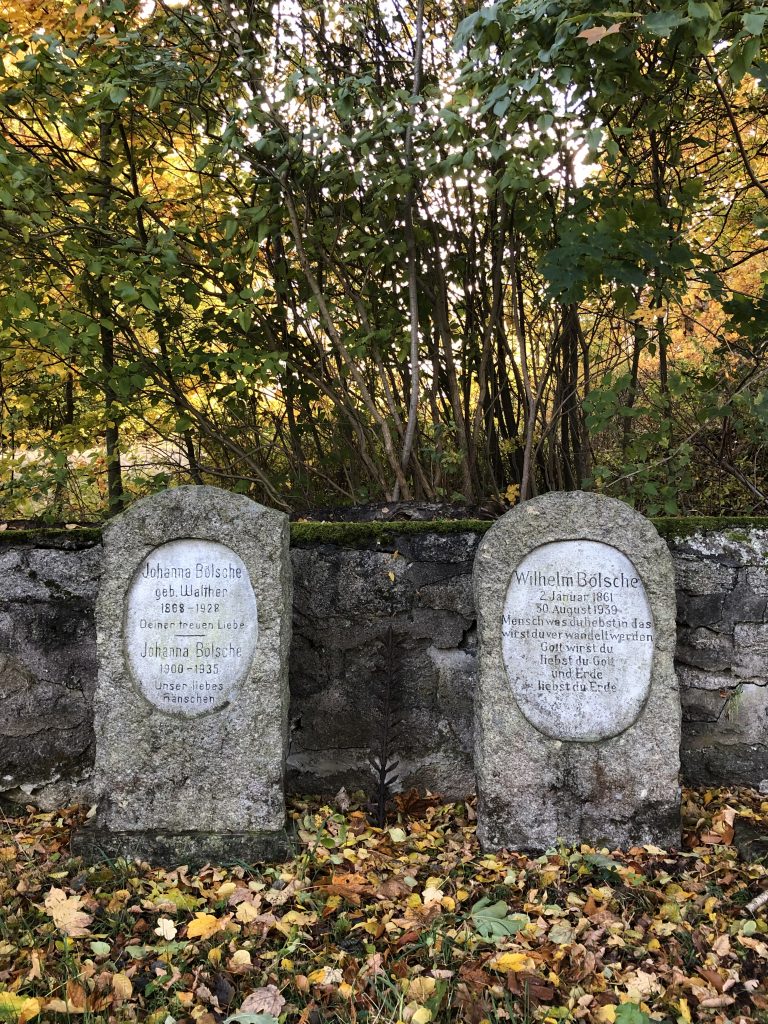I visited the Protestant cemetery in Schreiberhau (Szklarska Poręba) for the first time a few years ago, and despite serious damages, I felt its uniqueness right away. Beautifully situated on a hill, quiet and forgotten.

Old Protestant cemetery at Waryńskiego 3 in Szklarska Poręba (Schreiberhau) / Photo by Marta Maćkowiak
I remember that it was difficult to walk through the overgrown alleys, the tombstones were unreadable, and the larger crypts were damaged and unsecured (I even saw a tibia in one of them). What a pleasant surprise was to learn about the social initiative Mogiłę Ocal od Zawalenia (Save the Tomb from Collapse). A group of German volunteers and the inhabitants of Szklarska Poręba organised themselves and decided to clean the cemetery and take care of the headstones. On October 23, 2021 at 4:00 p.m., I had a chance to attend the ceremony of replacing the tombstone of Carl Hauptmann, writer, playwright, philosopher and older brother of the Nobel Prize winner, Gerhart Hauptmann. Carl was an author of, among other things, The Book of the Mountain Spirit (Rübezahl), a significant character in this region.
Carl’s original tombstone, designed by his friends Hans and Marlene Poelzig, was unveiled on June 23, 1925. The following quote from a Silesian song was written on it:
“I rest here under a rose and a clover,
I will never be lost under them.
And every tear of mourning
which will drip from your eye,
will fill my grave with memory.
Every time when you are happy,
My grave is full of fragrant roses. “
Sadly the tombstone was destroyed, then reconstructed and now it is safe in the museum – the Hauptmann House in Szklarska Poręba.
On the left – unveiling the new tombstone of Carl Hauptmann / Photo by Marta Maćkowiak
On the right – Carl’s original tombstone / Source: The Hauptmann House
The necropolis was established in 1844 as a separate Protestant cemetery, but eventually people of other religions began to be buried here as well. The last burials took place around 1946 and since then it is abandoned. The cemetery is unique not only because of its location and mysterious aura – we can find here the graves of many painters, writers and outstanding people associated with the world of science in the 19th and 20th centuries. Before World War II, the Giant Mountains (German: Riesengebirge, Polish: Karkonosze) attracted crowds of artists who created an artistic colony in Szklarska Poręba which was a social phenomenon.
For example, the tombstones of Wilhelm Bölsche, his wife Joanna née Walther and their daughter, also called Johanna, have been preserved here.
William was a man of many talents – he was a writer, biologist, and literary critic. In the 1930s, he created a small, no longer existing, geological and natural museum at 5 Muzealna Street (ul. Muzealna 5).

The headstones of Wilhelm Bölsche, his wife Johanna Bolsche Walther and their daughter, Johanna / Photo by Marta Maćkowiak
In the central part of cemetery, there are romantic ruins of the Preussler family chapel, the first owners of the glass factory in Schreiberhau (Szklarska Poręba).

Photo by Marta Maćkowiak
I also noticed several tombstones with bees on them. According to the cemetery symbols dictionary this motif was quite rare and was associated with dilligence, virginity and innocence. A bee was considered to be a sacred being.
Photos by Marta Maćkowiak
I am so glad to see such a change. It seems that the cemetery will be no longer forgotten. I have heard that the historical walks will be organized soon and participants will have an opportunity to learn about the outstanding people who rest there and to restore the memory of all the pre-war inhabitants of Schreiberhau.
Photos by Marta Maćkowiak
Sources:
Końcowy raport składa się z kopi odnalezionych dokumentów, tłumaczeń, zdjęć oraz podsumowania. Wyjaśniam pokrewieństwo odnalezionych osób, opisuję sprawdzone źródła i kontekst historyczny. Najczęściej poszukiwania dzielone są na parę etapów i opisuję możliwości kontynuacji.
Czasem konkretny dokument może zostać nie odnaleziony z różnych przyczyn – migracji do innych wiosek/miast w dalszych pokoleniach, ochrzczenia w innej parafii, lukach w księgach, zniszczeń dokumentów w pożarach lub w czasie wojen. Cena końcowa w takiej sytuacji nie ulega zmienia, ponieważ wysiłek włożony w poszukiwania jest taki sam bez względu na rezultat.
Raporty mogą się od siebie mniej lub bardziej różnić w zależności od miejsca, z którego rodzina pochodziła (np. dokumenty z zaboru pruskiego, austriackiego i rosyjskiego różnią się od siebie formą i treścią).
Na podstawie zebranych informacji (Twoich i moich) przygotuję plan i wycenę – jeśli ją zaakceptujesz, po otrzymaniu zaliczki rozpoczynam pracę i informuję o przewidywanym czasie ukończenia usługi. Standardowe poszukiwania trwają około 1 miesiąca, a o wszelkich zmianach będę informować Cię na bieżąco.
Na Twoje zapytanie odpiszę w ciągu 3 dni roboczych i jest to etap bezpłatny. Być może zadam parę dodatkowych pytań, dopytam o cele albo od razu przedstawię propozycję kolejnych kroków.
Warto pamiętać, że im więcej szczegółów podasz, tym więcej rzeczy mogę odkryć.
Podziel się ze mną:
I najważniejsze – jeśli masz niewiele informacji, zupełnie się tym nie martw, w takich sytuacjach także znajdę rozwiązanie.